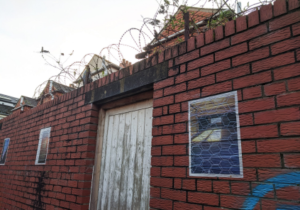Limin-alley: a lockdown art experience in Belfast
As a complement to JME 46.3: International Perspectives: What is Museum Education, we are please to share this article by former MER Board member Margaret Middleton. This article was originally posted on Museums Association on May 18, 2021.

Between the long rows of terraced homes in Belfast run narrow alleys: not-quite-footpath, not-quite-road. Both public and private, they seem to belong to everyone and no one. Most remain neglected and empty.
But on one weekend in March the alleys came alive with people, tucking into the alleys, following maps in search of art that awaited them on mossy brick walls, framed by backdoors and bins.
Arts producer Meadhbh McIlgorm dreamt up Limin-alley in response to lockdown. With the galleries closed, artists’ shows had been cancelled and with the pubs closed, people were missing the casual spontaneity of pre-lockdown socialising. McIlgorm wanted to engage her fellow artists and her neighbours.

The installation was a collaboration between McIlgorm and 9 Ft in Common, a group led by Amberlea Neely, who specialises in creative placemaking, and Aisling Rusk, an architect with a focus on contested spaces. 9 Ft in Common leads alley walks and advocates against the use of locked alley gates, a kind of securitised infrastructure that continues to divide an already divided city.

They also produced a map of the alleys, something that had never existed before.
McIlgorm met Neely and Rusk at the pilot version of Limin-alley last October in the alley behind her home. They connected over their mutual affinity for the liminal space of the alley and together planned a collaborative second installation of Limin-alley in March 2021 as part of the Imagine! Festival of Ideas and Politics. The pop-up exhibition lasted four days and featured the work of 12 commissioned local artists.
McIlgorm is used to producing indoor installations and though the show did have its challenges, she enjoyed the freedom that came with creating in an unusual locale with no preconceptions from the public.

specifically to respond to 9 Ft in Common’s research that found that street art in alleys fostered connection
She credits her background in craft and art education for her ability to approach the installation with a lack of preciousness, setting aside the usual gallery concerns of protecting art from the elements and from people.
There would be no roof to shield the art from inevitable rain and no gallery attendant to make sure visitors did not touch the work. It was up to artists how to respond to these unique conditions. Some chose impervious materials like waterproof signboard and others chose ephemeral materials like newsprint and papier-mâché that decomposed and changed over time.
Peppered among the artworks were concepts and prototypes developed by 9 Ft in Common, illustrating innovative ideas for activating alleys with plantings and seating or taking ownership of the alleys by bestowing them with names.
Several concepts were accompanied by prototypes that visitors could use, like a fold-out bench and a mounted mirror that reveals a glimpse around the corner.
Neely and Rusk describe alleys as intimate in-between spaces, quieter than the main street and private enough to feel comfortable popping out in your pyjamas to fetch the bin.

descriptions. This poster describes a mirror installed in such a way that residents walking down the alley
can see around the corner
The alleys were primed for social use and Limin-alley was the catalyst, offering a place for artists and neighbours to bond with one another over the delight of discovering art in unexpected places.
This year so many of us have missed the simple pleasure of enjoying art with friends. For those of us who ventured into the alleys this March, maps in hand, Limin-alley was just what we needed to get us through yet another weekend in lockdown.
Margaret Middleton is an independent exhibit designer currently based in Belfast, Northern Ireland and working at the intersection of design and social justice. They are an MA rep for Northern Ireland.

